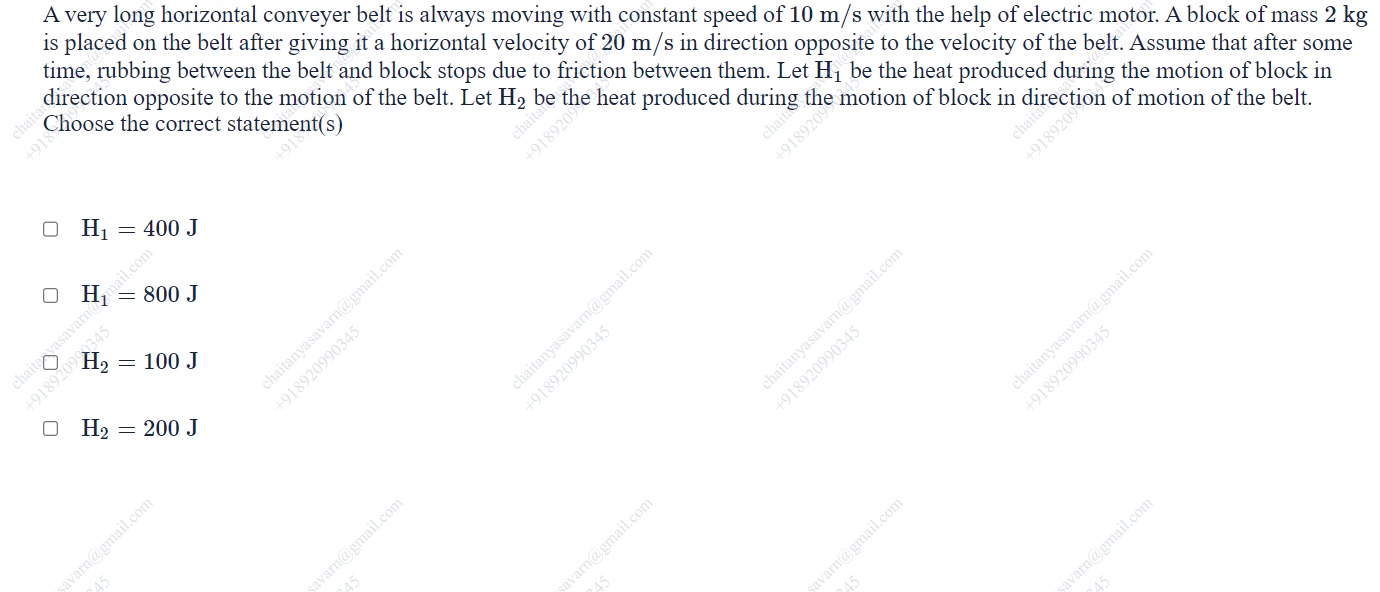Question
Question: A very long horizontal conveyer belt is always moving with constant speed of 10 m/s with the help of...
A very long horizontal conveyer belt is always moving with constant speed of 10 m/s with the help of electric motor. A block of mass 2 kg is placed on the belt after giving it a horizontal velocity of 20 m/s in direction opposite to the velocity of the belt. Assume that after some time, rubbing between the belt and block stops due to friction between them. Let H₁ be the heat produced during the motion of block in direction opposite to the motion of the belt. Let H₂ be the heat produced during the motion of block in direction of motion of the belt. Choose the correct statement(s)

H₁ = 400 J
H₁ = 800 J
H₂ = 100 J
H₂ = 200 J
H₁ = 800 J, H₂ = 100 J
Solution
Let the velocity of the conveyor belt be vb=+10 m/s. The initial velocity of the block is vi=−20 m/s (opposite to the belt's velocity). The mass of the block is m=2 kg.
The friction force acting on the block is kinetic friction as long as there is relative motion. The magnitude of the kinetic friction force is fk=μkN=μkmg, where μk is the coefficient of kinetic friction and N=mg is the normal force.
The relative velocity of the block with respect to the belt is vrel=vblock−vbelt.
Initially, vrel,i=−20−10=−30 m/s. The block is moving to the left relative to the belt.
The friction force on the block is in the direction opposite to the relative velocity of the block with respect to the belt, i.e., in the direction of the belt's velocity (positive direction).
The acceleration of the block is a=mfk=mμkmg=μkg. This acceleration is constant and in the positive direction.
The velocity of the block at time t is v(t)=vi+at=−20+μkgt.
The block starts with v=−20 m/s and accelerates towards the positive direction. Its velocity increases from -20 m/s, passes through 0 m/s, and eventually reaches +10 m/s, at which point the relative velocity is zero (10−10=0), and the block moves with the belt.
Let's define the phases based on the direction of the block's motion relative to the ground.
Phase 1: The block moves in the direction opposite to the belt's motion. This happens when the block's velocity v is negative. The velocity changes from -20 m/s to 0 m/s.
Let t1 be the time when the block's velocity becomes 0 m/s.
0=−20+μkgt1⟹t1=μkg20.
During this phase (0≤t≤t1), the block moves in the negative direction.
Let's calculate the heat produced during this phase, H1. Heat produced by friction is H=fk×∣Δxrel∣, where ∣Δxrel∣ is the magnitude of the relative displacement between the surfaces during the period when kinetic friction acts.
The relative velocity is vrel(t)=v(t)−vb=(−20+μkgt)−10=−30+μkgt.
The relative displacement during Phase 1 (0≤t≤t1) is Δxrel,1=∫0t1vrel(t)dt=∫0t1(−30+μkgt)dt=[−30t+21μkgt2]0t1.
Substitute t1=μkg20:
Δxrel,1=−30(μkg20)+21μkg(μkg20)2=−μkg600+21μkg(μkg)2400=−μkg600+μkg200=−μkg400.
The magnitude of the relative displacement is ∣Δxrel,1∣=μkg400.
The heat produced H1=fk×∣Δxrel,1∣=(μkmg)×μkg400=400m.
Given m=2 kg, H1=400×2=800 J.
Phase 2: The block moves in the direction of the belt's motion. This happens when the block's velocity v is positive. The velocity changes from 0 m/s to +10 m/s.
Let t2 be the time when the block's velocity becomes +10 m/s.
10=−20+μkgt2⟹t2=μkg30.
This phase occurs during the time interval [t1,t2].
During this phase (t1≤t≤t2), the block moves in the positive direction.
The relative velocity is vrel(t)=−30+μkgt.
At t=t1=μkg20, vrel(t1)=−30+μkg(μkg20)=−30+20=−10 m/s.
At t=t2=μkg30, vrel(t2)=−30+μkg(μkg30)=−30+30=0 m/s.
The relative velocity is negative during this phase, meaning the block is still moving to the left relative to the belt.
The relative displacement during Phase 2 (t1≤t≤t2) is Δxrel,2=∫t1t2vrel(t)dt=∫t1t2(−30+μkgt)dt=[−30t+21μkgt2]t1t2.
Substitute t1=μkg20 and t2=μkg30:
Δxrel,2=(−30(μkg30)+21μkg(μkg30)2)−(−30(μkg20)+21μkg(μkg20)2).
Δxrel,2=(−μkg900+μkg450)−(−μkg600+μkg200).
Δxrel,2=(−μkg450)−(−μkg400)=−μkg50.
The magnitude of the relative displacement is ∣Δxrel,2∣=μkg50.
The heat produced H2=fk×∣Δxrel,2∣=(μkmg)×μkg50=50m.
Given m=2 kg, H2=50×2=100 J.
So, H1=800 J and H2=100 J.
